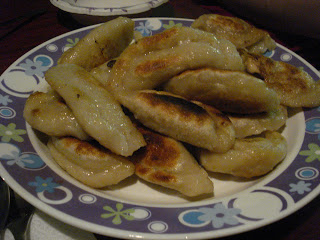Fusion cuisine or not, the food turned out to be really good. My favorite was the bok choy. I was craving green vegetables after being stuck at school all week; weekends are my time to go home and eat my leafy green veggies. The bok choy was boiled and then simply dressed with some oyster sauce and sesame oil - so good and easy. If I had more vegetables, I would make them in this style.
 |
My second favorite dish was the fried rice. It had lap cheong, or Chinese sausage, in it, and I love fried rice with Chinese sausage. Chinese sausage just adds such flavor to fried rice, or any dish for that matter. If you can eat pork, and you can stomach an ingredient list that reads like a liposuction checklist (pork back fat, pork fat....), then I would get a package of Chinese sausage from an Asian grocery store posthaste. It's really easy to cook, and so versatile. But perhaps that's a different post.
The fish came out better than I thought it would. I tried my best to follow this recipe, but I was lacking a lot of things. The two ingredients I was most irritated about not having were the green onions and the shaoxing rice wine. Last semester, I grew green onions on my windowsill so I could always have them, but after I forgot to change the water a couple of times, some funky stuff grew alongside the green onions and I ended up throwing them away. I was going to buy some green onions at a pre-storm shopping trip, but for whatever reason, I decided against it, leaving me green onion-less for New Year's dinner. I've also been meaning to take some rice wine from my house so I don't have to buy an entire bottle to keep at school, but I also didn't do that before being trapped in my apartment. I know dry sherry is the traditionally recommended shaoxing substitute, but I don't have dry sherry. Google told me that a dry white wine or sake could be substituted, and I fortunately have some sake that no one wants to drink.
I actually enjoyed steaming process. I used my MacGyver skills in the kitchen to rig up a steam setup (actually, I just remembered a tip from David Chang's Momofuku book about elevating dishes out of water).
The plate with the fish went on the foil donut, and a lid went over the plate. I say "the lid went over the plate" and not "the lid went on the wok" because the wok doesn't have a lid. We took a big pot lid and put it over the plate, trying not to touch the fish. The fish was steamed until done, the ginger was discarded and new ginger added, hot oil was poured over the ginger and fish, and a soy sauce/sake/brown sugar sauce was cooked and poured over the oily fish. Except, the hot oil poured over the fish wasn't hot enough to crisp anything or heat the ginger, so I ended up pouring the soy mixture over the fish, deciding I was unhappy with the dish, pouring all the liquids back together in the wok to heat up, and trying again. It came out tasting okay. Not restaurant-quality, but it wasn't bad.
The instant udon was nothing special. I really love instant udon, so it was awesome for me, but it wasn't anything I would bring out for special occasions. I just followed package directions and cooked it.
All-in-all, we had a lot of food to eat, an excellent way to celebrate the Year of the Rabbit!
And, of course, we had oranges and tangerines for dessert. I cut the oranges into their own serving bowl at my sister's request.
As a digression, I would just like to say that I could not have cooked this dinner without all the stuff I've accumulated in my kitchen. Lack of rice wine aside, I had enough sauces, spices, and other consumable goods to actually make dinner good. If you are ever about to be trapped in a snowstorm, I would say, in all seriousness, buy a lot of shit. Cooking is a lot easier to improvise if you have a lot of materials to work with. Especially sesame oil and Chinese sausage. That stuff makes anything taste and smell delicious.
 |
| Pink Bunny eating orange fruits and drinking orange drink. |













